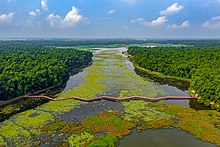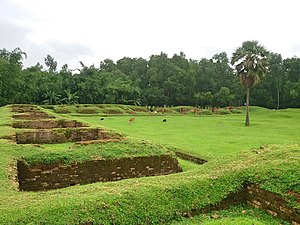Nawabganj Upazila, Dinajpur
Nawabganj
নবাবগঞ্জ | |
|---|---|
 | |
| Coordinates: 25°25′N 89°5′E / 25.417°N 89.083°E | |
| Country | |
| Division | Rangpur |
| District | Dinajpur |
| Government | |
| • Chief Executive Officer | Md. Anisur Rahman |
| Area | |
• Total | 314.68 km2 (121.50 sq mi) |
| Population | |
• Total | 254,036 |
| • Density | 810/km2 (2,100/sq mi) |
| Time zone | UTC+6 (BST) |
| Postal code | 5280[2] |
| Website | Official Map of Nawabganj |
Nawabganj (Bengali: নবাবগঞ্জ; Bengali pronunciation: [Nobabgonj]) is an upazila of Dinajpur District in the Division of Rangpur, Bangladesh.[3]
Geography
[edit]Nawabganj is located at 25°25′00″N 89°05′00″E / 25.4167°N 89.0833°E. It has a total area of 314.68 km2. The upazila is bounded by Parbatipur upazila on the north, Ghoraghat and Hakimpur upazilas on the south, Pirganj, Mithapukur and Badarganj upazilas on the east, Birampur and Phulbari upazilas on the west. Nawabganj Upazila has 60 thousand metric tonnes of coal, stored in a village called Dighipara.
Demographics
[edit]According to the 2011 Census of Bangladesh, Nawabganj Upazila had 57,851 households and a population of 229,337. 50,979 (22.23%) were under 10 years of age. Nawabganj had a literacy rate (age 7 and over) of 42.83%, compared to the national average of 51.8%, and a sex ratio of 998 females per 1000 males. 7,225 (3.15%) lived in urban areas.[5] Ethnic population was 10,508 (4.58%), of which Santal were 8,496 and Oraon 731.[6]
As of the 1991 Bangladesh census, Nawabganj has a population of 170301. Males constitute 51.28% of the population, and females 48.72%. This Upazila's eighteen up population is 88690. Nawabganj has an average literacy rate of 24.2% (7+ years), and the national average of 32.4% literate.[7]
Economy
[edit]Dighipara a small village under Putimara Union, is the largest deposit of coal, mainly anthracites and silica in Bangladesh. BAPEX have already surveyed the underground deposits in 1994. Villagers want well-justified decisions that facilitates both the country, environment and residents nearby. As controversial dispute in Phulbari Coal mine project with Asia Energy, Government of Bangladesh and local people; Dighipara will be a free, transparent solution for both the energy crisis and demands of the local people.
Points of interest
[edit]
A well balanced ecosystem in the 517.61 hectares of Shal forest and a lake is a tourist attraction here. It includes a unique canal system and a 3–4 km region with ambient atmosphere. Guest birds are available year-round. It was declared as National forest under the Name "Nawabganj National Forest" at 24/10/2010 by the People's Republic of Bangladesh.
Administration
[edit]Nawabganj Upazila is divided into Nawabganj Municipality and nine union parishads: Bhaduria, Binodnagar, Daudpur, Golapgonj, Joypur, Kushdaha, Mahmudpur, Putimara, and Shalkhuria. The union parishads are subdivided into 212 mauzas and 272 villages.[5]
Education
[edit]There are a number of educational institutions including degree colleges, mohila degree colleges, high schools, madrashas, and primary school. Aftabganj Degree College, Daudpur Degree College, Daudpur M.L. High School, Hatisal Fazil Madrasha, Boalmari/Kanchdoho Fazil Madrasha, Raghobendrapur Alim Senior Madrasah are noted ones. All these institutions provide qualified sound education.
References
[edit]- ^ National Report (PDF). Population and Housing Census 2022. Vol. 1. Dhaka: Bangladesh Bureau of Statistics. November 2023. p. 403. ISBN 978-9844752016.
- ^ "Bangladesh Postal Code". Dhaka: Bangladesh Postal Department under the Department of Posts and Telecommunications of the Ministry of Posts, Telecommunications and Information Technology of the People's Republic of Bangladesh. 21 October 2024.
- ^ S.M Mahfuzur Rahman (2012). "Nawabganj Upazila (Dinajpur District)". In Sirajul Islam and Ahmed A. Jamal (ed.). Banglapedia: National Encyclopedia of Bangladesh (Second ed.). Asiatic Society of Bangladesh.
- ^ Population and Housing Census 2022 - District Report: Dinajpur (PDF). District Series. Dhaka: Bangladesh Bureau of Statistics. June 2024. ISBN 978-984-475-270-2.
- ^ a b "Bangladesh Population and Housing Census 2011 Zila Report – Dinajpur" (PDF). bbs.gov.bd. Bangladesh Bureau of Statistics.
- ^ "Community Tables: Dinajpur district" (PDF). bbs.gov.bd. Bangladesh Bureau of Statistics. 2011.
- ^ "Population Census Wing, BBS". Archived from the original on 2005-03-27. Retrieved November 10, 2006.
- ^ উপজেলা নির্বাহী অফিসার. 2024-08-27. Archived from the original on 2024-08-27.



